BTEC HRM Unit 3: Recruitment Process Analysis for Marks & Spencer
VerifiedAdded on 2023/01/07
|18
|5418
|47
Report
AI Summary
This report provides a comprehensive analysis of the recruitment process within Marks & Spencer (M&S), examining various aspects of Human Resource Management (HRM). It begins with an introduction to HRM, its purpose, and scope, specifically in the context of M&S. The report delves into the functions of HRM, including managerial, operative, and advisory functions, illustrating their application within the company. It then explores different approaches to recruitment and selection, such as internal job postings and social media postings, evaluating their advantages and disadvantages. The core of the report focuses on the benefits of HRM practices at M&S, particularly the recruitment and selection process, talent management, training and development, performance evaluation, reward, and employee engagement. Furthermore, the report investigates the impact of employee relations and employment legislation on HRM decision-making. The report concludes with an analysis of the implementation of HRM practices in M&S, using specific examples to illustrate key concepts. The report also includes a table of contents, references, and adheres to the structure of the provided assignment brief.
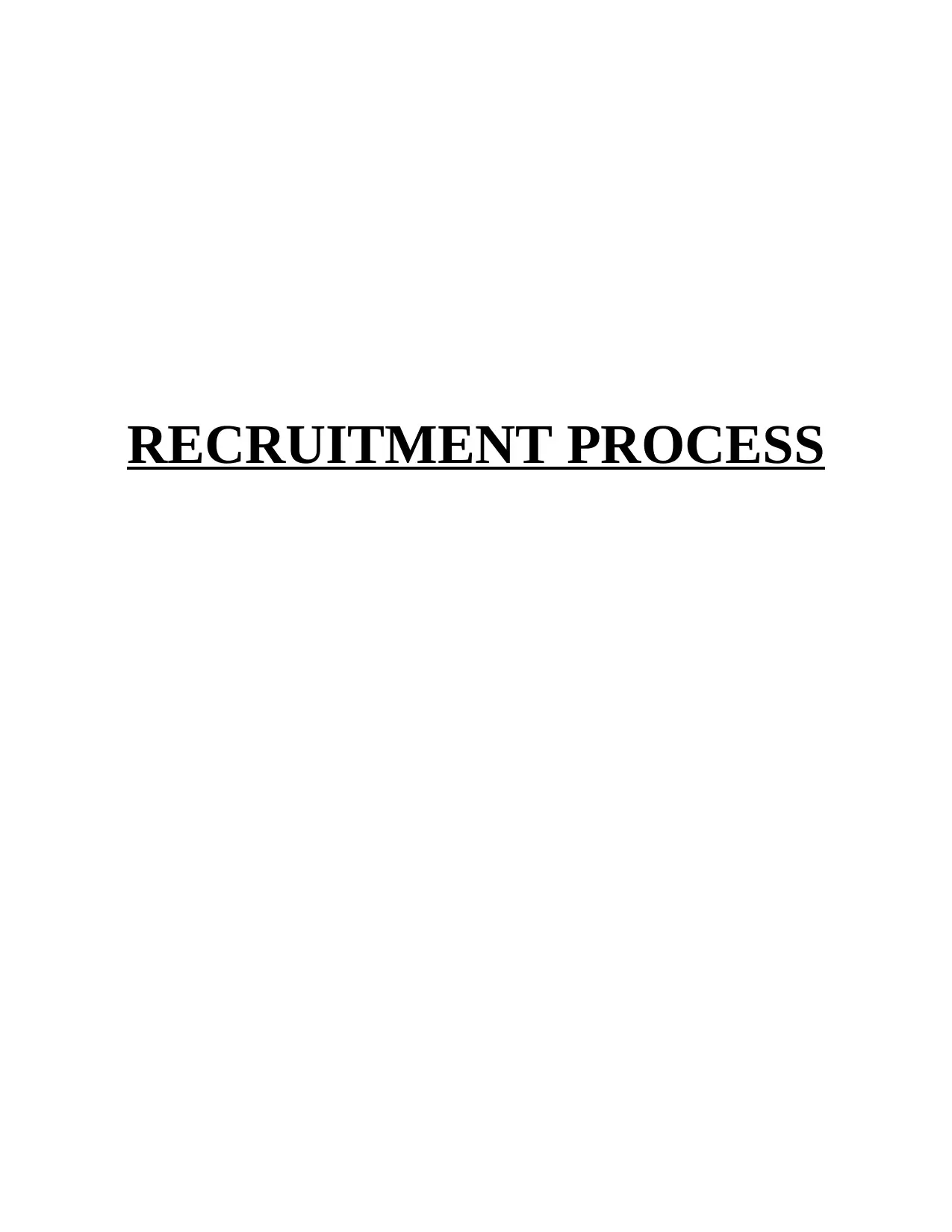
RECRUITMENT PROCESS
Paraphrase This Document
Need a fresh take? Get an instant paraphrase of this document with our AI Paraphraser
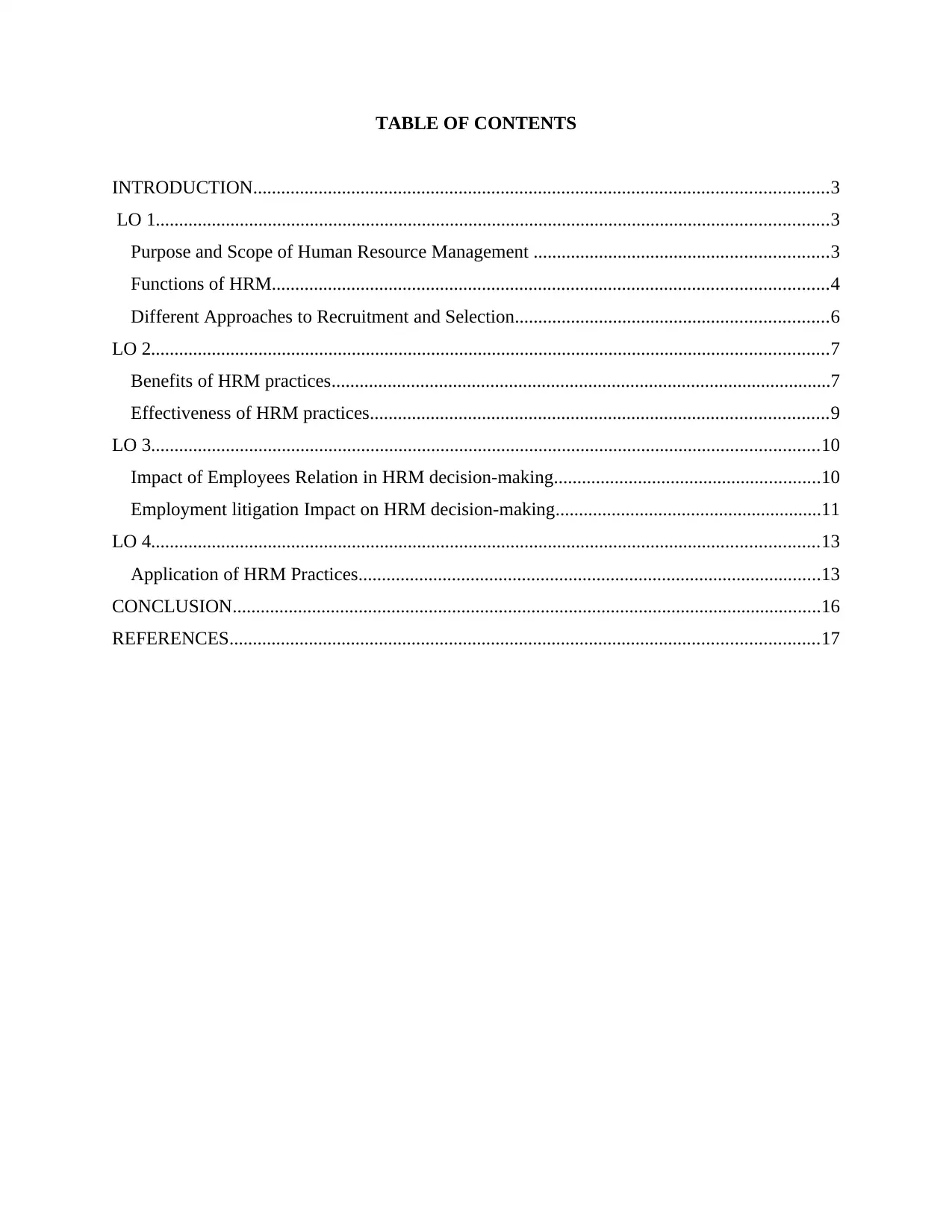
TABLE OF CONTENTS
INTRODUCTION...........................................................................................................................3
LO 1................................................................................................................................................3
Purpose and Scope of Human Resource Management ...............................................................3
Functions of HRM.......................................................................................................................4
Different Approaches to Recruitment and Selection...................................................................6
LO 2.................................................................................................................................................7
Benefits of HRM practices...........................................................................................................7
Effectiveness of HRM practices..................................................................................................9
LO 3...............................................................................................................................................10
Impact of Employees Relation in HRM decision-making.........................................................10
Employment litigation Impact on HRM decision-making.........................................................11
LO 4...............................................................................................................................................13
Application of HRM Practices...................................................................................................13
CONCLUSION..............................................................................................................................16
REFERENCES..............................................................................................................................17
INTRODUCTION...........................................................................................................................3
LO 1................................................................................................................................................3
Purpose and Scope of Human Resource Management ...............................................................3
Functions of HRM.......................................................................................................................4
Different Approaches to Recruitment and Selection...................................................................6
LO 2.................................................................................................................................................7
Benefits of HRM practices...........................................................................................................7
Effectiveness of HRM practices..................................................................................................9
LO 3...............................................................................................................................................10
Impact of Employees Relation in HRM decision-making.........................................................10
Employment litigation Impact on HRM decision-making.........................................................11
LO 4...............................................................................................................................................13
Application of HRM Practices...................................................................................................13
CONCLUSION..............................................................................................................................16
REFERENCES..............................................................................................................................17
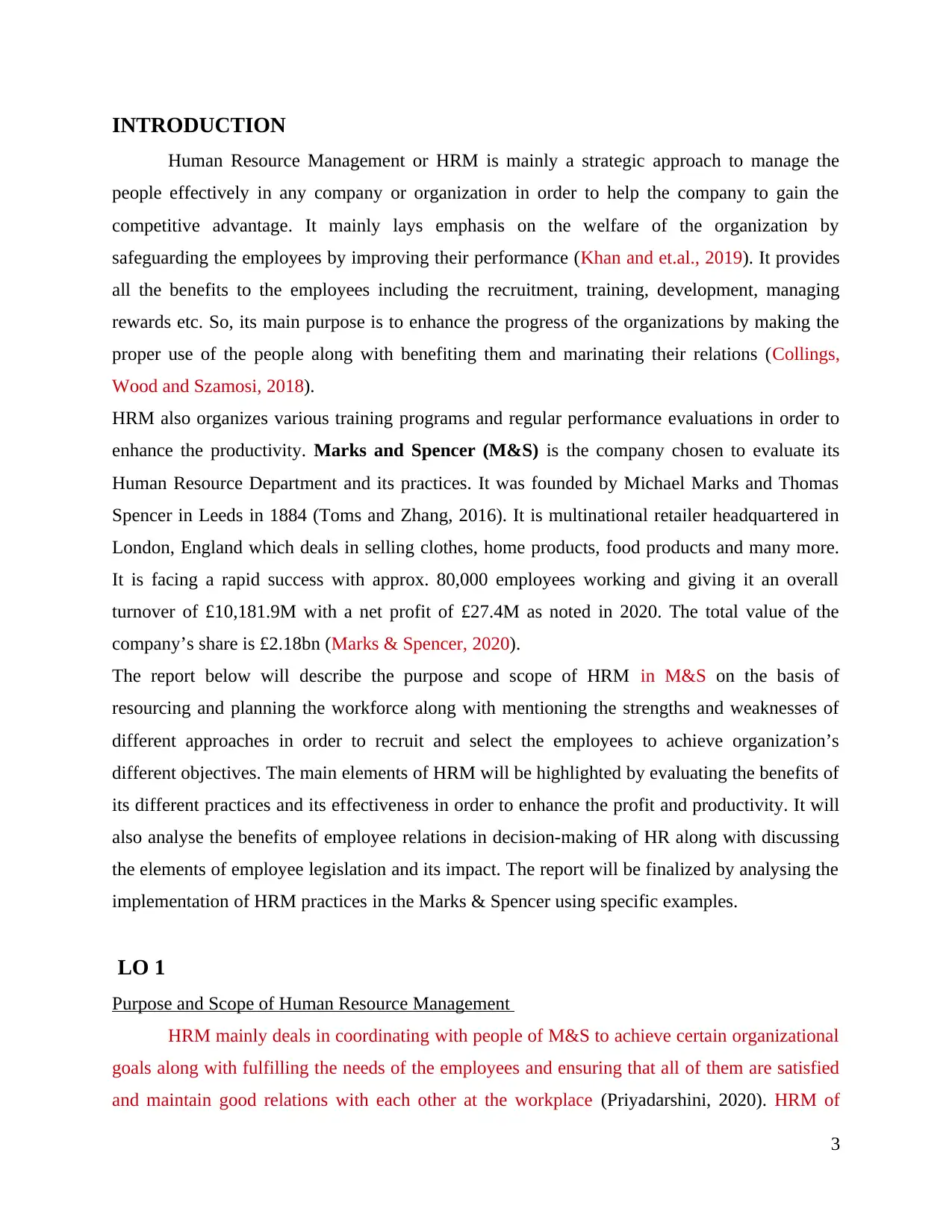
INTRODUCTION
Human Resource Management or HRM is mainly a strategic approach to manage the
people effectively in any company or organization in order to help the company to gain the
competitive advantage. It mainly lays emphasis on the welfare of the organization by
safeguarding the employees by improving their performance (Khan and et.al., 2019). It provides
all the benefits to the employees including the recruitment, training, development, managing
rewards etc. So, its main purpose is to enhance the progress of the organizations by making the
proper use of the people along with benefiting them and marinating their relations (Collings,
Wood and Szamosi, 2018).
HRM also organizes various training programs and regular performance evaluations in order to
enhance the productivity. Marks and Spencer (M&S) is the company chosen to evaluate its
Human Resource Department and its practices. It was founded by Michael Marks and Thomas
Spencer in Leeds in 1884 (Toms and Zhang, 2016). It is multinational retailer headquartered in
London, England which deals in selling clothes, home products, food products and many more.
It is facing a rapid success with approx. 80,000 employees working and giving it an overall
turnover of £10,181.9M with a net profit of £27.4M as noted in 2020. The total value of the
company’s share is £2.18bn (Marks & Spencer, 2020).
The report below will describe the purpose and scope of HRM in M&S on the basis of
resourcing and planning the workforce along with mentioning the strengths and weaknesses of
different approaches in order to recruit and select the employees to achieve organization’s
different objectives. The main elements of HRM will be highlighted by evaluating the benefits of
its different practices and its effectiveness in order to enhance the profit and productivity. It will
also analyse the benefits of employee relations in decision-making of HR along with discussing
the elements of employee legislation and its impact. The report will be finalized by analysing the
implementation of HRM practices in the Marks & Spencer using specific examples.
LO 1
Purpose and Scope of Human Resource Management
HRM mainly deals in coordinating with people of M&S to achieve certain organizational
goals along with fulfilling the needs of the employees and ensuring that all of them are satisfied
and maintain good relations with each other at the workplace (Priyadarshini, 2020). HRM of
3
Human Resource Management or HRM is mainly a strategic approach to manage the
people effectively in any company or organization in order to help the company to gain the
competitive advantage. It mainly lays emphasis on the welfare of the organization by
safeguarding the employees by improving their performance (Khan and et.al., 2019). It provides
all the benefits to the employees including the recruitment, training, development, managing
rewards etc. So, its main purpose is to enhance the progress of the organizations by making the
proper use of the people along with benefiting them and marinating their relations (Collings,
Wood and Szamosi, 2018).
HRM also organizes various training programs and regular performance evaluations in order to
enhance the productivity. Marks and Spencer (M&S) is the company chosen to evaluate its
Human Resource Department and its practices. It was founded by Michael Marks and Thomas
Spencer in Leeds in 1884 (Toms and Zhang, 2016). It is multinational retailer headquartered in
London, England which deals in selling clothes, home products, food products and many more.
It is facing a rapid success with approx. 80,000 employees working and giving it an overall
turnover of £10,181.9M with a net profit of £27.4M as noted in 2020. The total value of the
company’s share is £2.18bn (Marks & Spencer, 2020).
The report below will describe the purpose and scope of HRM in M&S on the basis of
resourcing and planning the workforce along with mentioning the strengths and weaknesses of
different approaches in order to recruit and select the employees to achieve organization’s
different objectives. The main elements of HRM will be highlighted by evaluating the benefits of
its different practices and its effectiveness in order to enhance the profit and productivity. It will
also analyse the benefits of employee relations in decision-making of HR along with discussing
the elements of employee legislation and its impact. The report will be finalized by analysing the
implementation of HRM practices in the Marks & Spencer using specific examples.
LO 1
Purpose and Scope of Human Resource Management
HRM mainly deals in coordinating with people of M&S to achieve certain organizational
goals along with fulfilling the needs of the employees and ensuring that all of them are satisfied
and maintain good relations with each other at the workplace (Priyadarshini, 2020). HRM of
3
⊘ This is a preview!⊘
Do you want full access?
Subscribe today to unlock all pages.

Trusted by 1+ million students worldwide
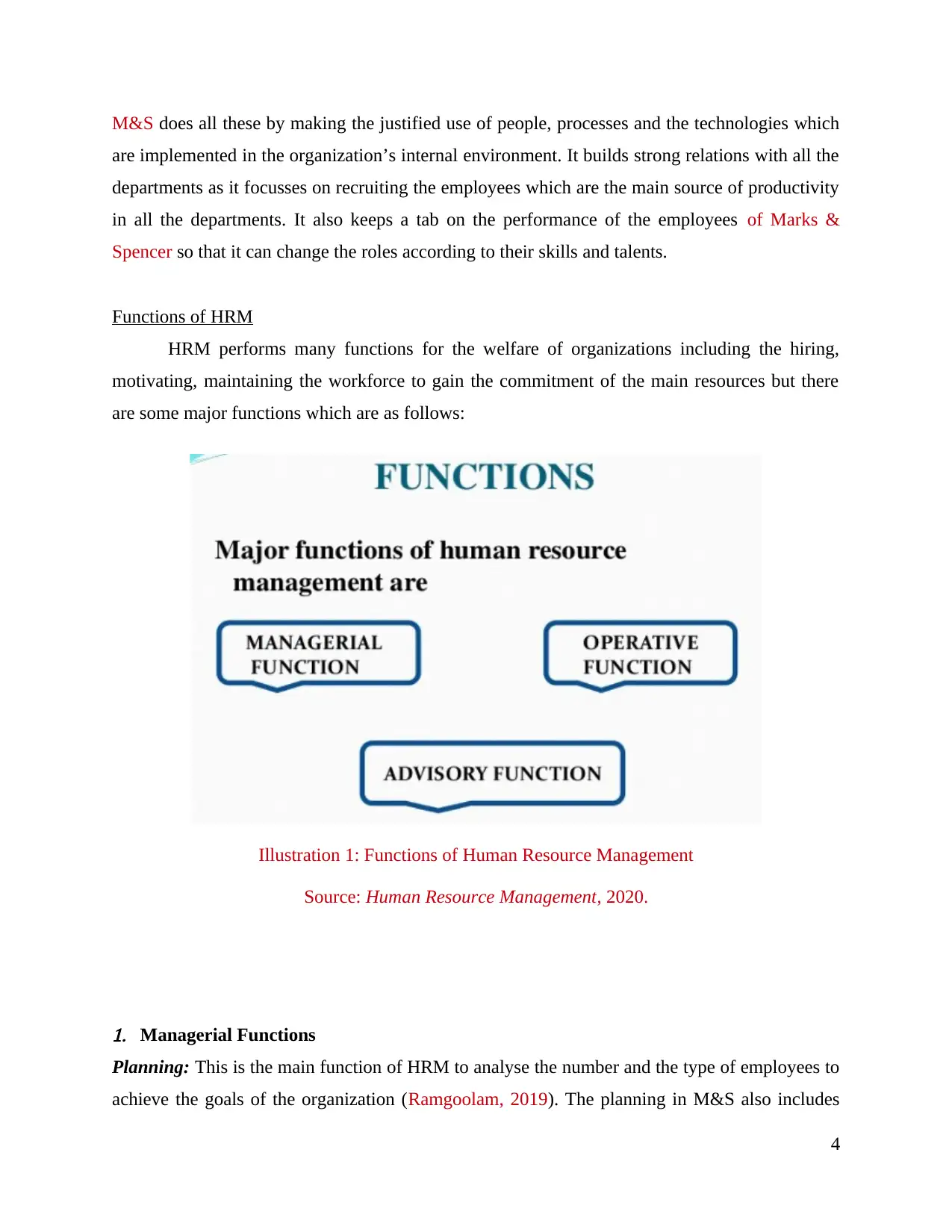
M&S does all these by making the justified use of people, processes and the technologies which
are implemented in the organization’s internal environment. It builds strong relations with all the
departments as it focusses on recruiting the employees which are the main source of productivity
in all the departments. It also keeps a tab on the performance of the employees of Marks &
Spencer so that it can change the roles according to their skills and talents.
Functions of HRM
HRM performs many functions for the welfare of organizations including the hiring,
motivating, maintaining the workforce to gain the commitment of the main resources but there
are some major functions which are as follows:
1. Managerial Functions
Planning: This is the main function of HRM to analyse the number and the type of employees to
achieve the goals of the organization (Ramgoolam, 2019). The planning in M&S also includes
4
Illustration 1: Functions of Human Resource Management
Source: Human Resource Management, 2020.
are implemented in the organization’s internal environment. It builds strong relations with all the
departments as it focusses on recruiting the employees which are the main source of productivity
in all the departments. It also keeps a tab on the performance of the employees of Marks &
Spencer so that it can change the roles according to their skills and talents.
Functions of HRM
HRM performs many functions for the welfare of organizations including the hiring,
motivating, maintaining the workforce to gain the commitment of the main resources but there
are some major functions which are as follows:
1. Managerial Functions
Planning: This is the main function of HRM to analyse the number and the type of employees to
achieve the goals of the organization (Ramgoolam, 2019). The planning in M&S also includes
4
Illustration 1: Functions of Human Resource Management
Source: Human Resource Management, 2020.
Paraphrase This Document
Need a fresh take? Get an instant paraphrase of this document with our AI Paraphraser
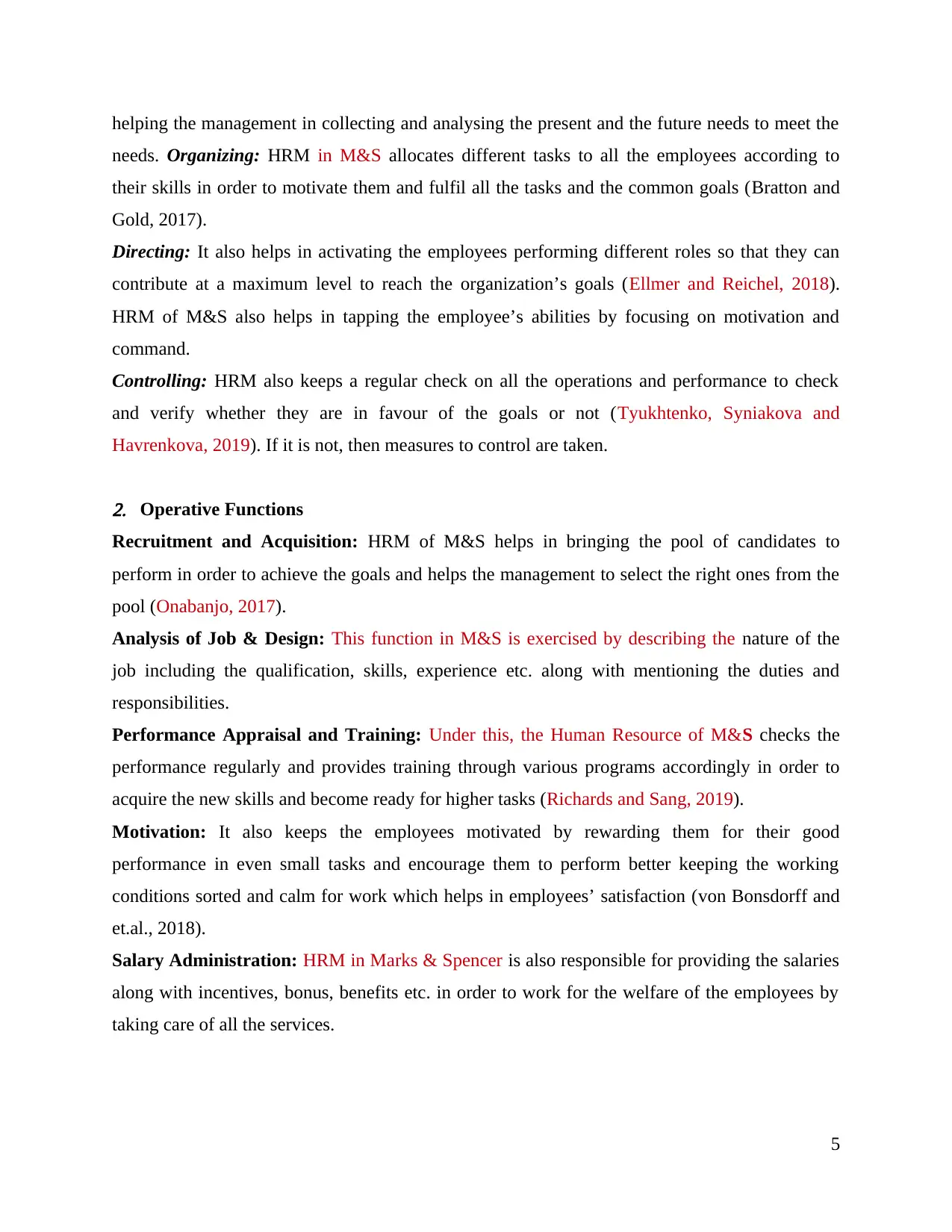
helping the management in collecting and analysing the present and the future needs to meet the
needs. Organizing: HRM in M&S allocates different tasks to all the employees according to
their skills in order to motivate them and fulfil all the tasks and the common goals (Bratton and
Gold, 2017).
Directing: It also helps in activating the employees performing different roles so that they can
contribute at a maximum level to reach the organization’s goals (Ellmer and Reichel, 2018).
HRM of M&S also helps in tapping the employee’s abilities by focusing on motivation and
command.
Controlling: HRM also keeps a regular check on all the operations and performance to check
and verify whether they are in favour of the goals or not (Tyukhtenko, Syniakova and
Havrenkova, 2019). If it is not, then measures to control are taken.
2. Operative Functions
Recruitment and Acquisition: HRM of M&S helps in bringing the pool of candidates to
perform in order to achieve the goals and helps the management to select the right ones from the
pool (Onabanjo, 2017).
Analysis of Job & Design: This function in M&S is exercised by describing the nature of the
job including the qualification, skills, experience etc. along with mentioning the duties and
responsibilities.
Performance Appraisal and Training: Under this, the Human Resource of M&S checks the
performance regularly and provides training through various programs accordingly in order to
acquire the new skills and become ready for higher tasks (Richards and Sang, 2019).
Motivation: It also keeps the employees motivated by rewarding them for their good
performance in even small tasks and encourage them to perform better keeping the working
conditions sorted and calm for work which helps in employees’ satisfaction (von Bonsdorff and
et.al., 2018).
Salary Administration: HRM in Marks & Spencer is also responsible for providing the salaries
along with incentives, bonus, benefits etc. in order to work for the welfare of the employees by
taking care of all the services.
5
needs. Organizing: HRM in M&S allocates different tasks to all the employees according to
their skills in order to motivate them and fulfil all the tasks and the common goals (Bratton and
Gold, 2017).
Directing: It also helps in activating the employees performing different roles so that they can
contribute at a maximum level to reach the organization’s goals (Ellmer and Reichel, 2018).
HRM of M&S also helps in tapping the employee’s abilities by focusing on motivation and
command.
Controlling: HRM also keeps a regular check on all the operations and performance to check
and verify whether they are in favour of the goals or not (Tyukhtenko, Syniakova and
Havrenkova, 2019). If it is not, then measures to control are taken.
2. Operative Functions
Recruitment and Acquisition: HRM of M&S helps in bringing the pool of candidates to
perform in order to achieve the goals and helps the management to select the right ones from the
pool (Onabanjo, 2017).
Analysis of Job & Design: This function in M&S is exercised by describing the nature of the
job including the qualification, skills, experience etc. along with mentioning the duties and
responsibilities.
Performance Appraisal and Training: Under this, the Human Resource of M&S checks the
performance regularly and provides training through various programs accordingly in order to
acquire the new skills and become ready for higher tasks (Richards and Sang, 2019).
Motivation: It also keeps the employees motivated by rewarding them for their good
performance in even small tasks and encourage them to perform better keeping the working
conditions sorted and calm for work which helps in employees’ satisfaction (von Bonsdorff and
et.al., 2018).
Salary Administration: HRM in Marks & Spencer is also responsible for providing the salaries
along with incentives, bonus, benefits etc. in order to work for the welfare of the employees by
taking care of all the services.
5
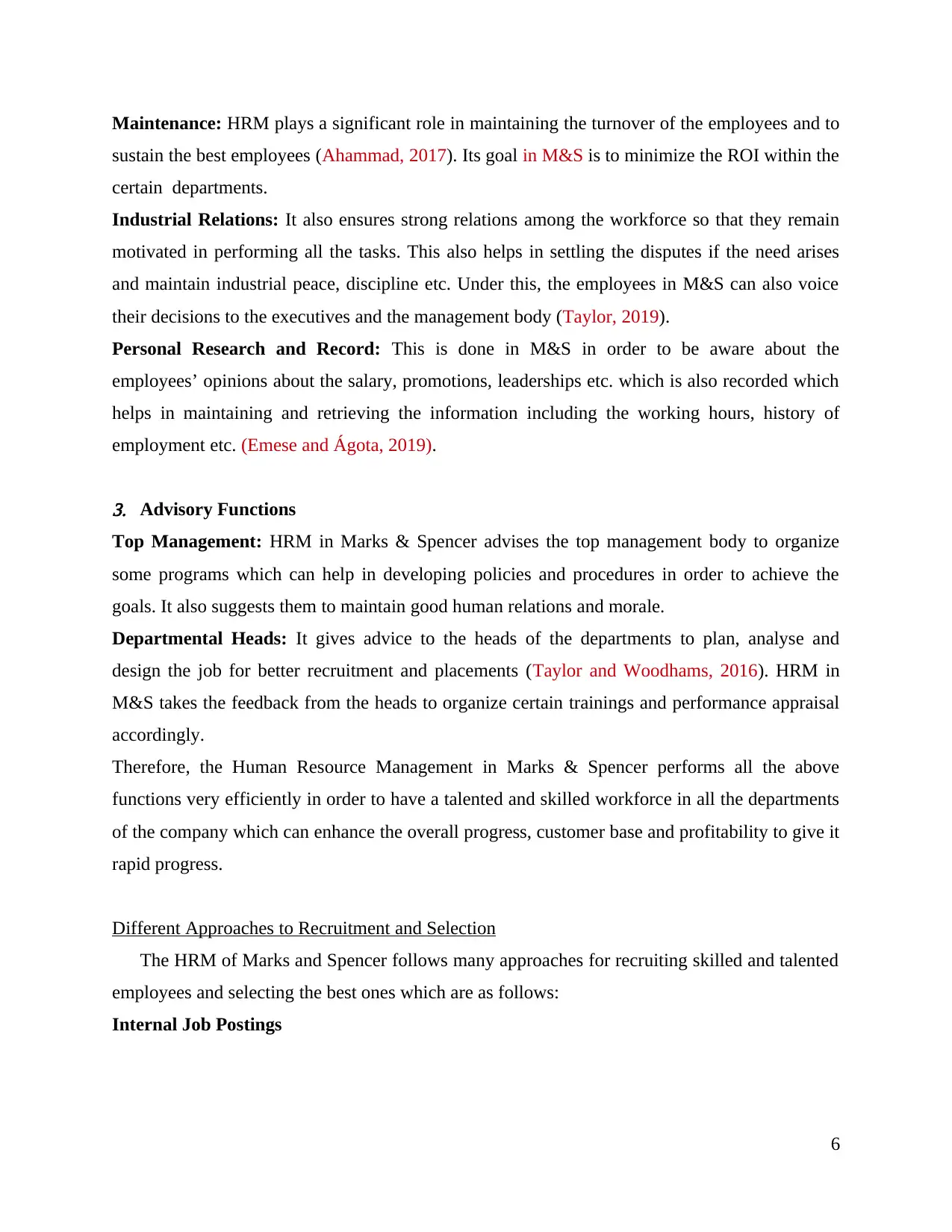
Maintenance: HRM plays a significant role in maintaining the turnover of the employees and to
sustain the best employees (Ahammad, 2017). Its goal in M&S is to minimize the ROI within the
certain departments.
Industrial Relations: It also ensures strong relations among the workforce so that they remain
motivated in performing all the tasks. This also helps in settling the disputes if the need arises
and maintain industrial peace, discipline etc. Under this, the employees in M&S can also voice
their decisions to the executives and the management body (Taylor, 2019).
Personal Research and Record: This is done in M&S in order to be aware about the
employees’ opinions about the salary, promotions, leaderships etc. which is also recorded which
helps in maintaining and retrieving the information including the working hours, history of
employment etc. (Emese and Ágota, 2019).
3. Advisory Functions
Top Management: HRM in Marks & Spencer advises the top management body to organize
some programs which can help in developing policies and procedures in order to achieve the
goals. It also suggests them to maintain good human relations and morale.
Departmental Heads: It gives advice to the heads of the departments to plan, analyse and
design the job for better recruitment and placements (Taylor and Woodhams, 2016). HRM in
M&S takes the feedback from the heads to organize certain trainings and performance appraisal
accordingly.
Therefore, the Human Resource Management in Marks & Spencer performs all the above
functions very efficiently in order to have a talented and skilled workforce in all the departments
of the company which can enhance the overall progress, customer base and profitability to give it
rapid progress.
Different Approaches to Recruitment and Selection
The HRM of Marks and Spencer follows many approaches for recruiting skilled and talented
employees and selecting the best ones which are as follows:
Internal Job Postings
6
sustain the best employees (Ahammad, 2017). Its goal in M&S is to minimize the ROI within the
certain departments.
Industrial Relations: It also ensures strong relations among the workforce so that they remain
motivated in performing all the tasks. This also helps in settling the disputes if the need arises
and maintain industrial peace, discipline etc. Under this, the employees in M&S can also voice
their decisions to the executives and the management body (Taylor, 2019).
Personal Research and Record: This is done in M&S in order to be aware about the
employees’ opinions about the salary, promotions, leaderships etc. which is also recorded which
helps in maintaining and retrieving the information including the working hours, history of
employment etc. (Emese and Ágota, 2019).
3. Advisory Functions
Top Management: HRM in Marks & Spencer advises the top management body to organize
some programs which can help in developing policies and procedures in order to achieve the
goals. It also suggests them to maintain good human relations and morale.
Departmental Heads: It gives advice to the heads of the departments to plan, analyse and
design the job for better recruitment and placements (Taylor and Woodhams, 2016). HRM in
M&S takes the feedback from the heads to organize certain trainings and performance appraisal
accordingly.
Therefore, the Human Resource Management in Marks & Spencer performs all the above
functions very efficiently in order to have a talented and skilled workforce in all the departments
of the company which can enhance the overall progress, customer base and profitability to give it
rapid progress.
Different Approaches to Recruitment and Selection
The HRM of Marks and Spencer follows many approaches for recruiting skilled and talented
employees and selecting the best ones which are as follows:
Internal Job Postings
6
⊘ This is a preview!⊘
Do you want full access?
Subscribe today to unlock all pages.

Trusted by 1+ million students worldwide
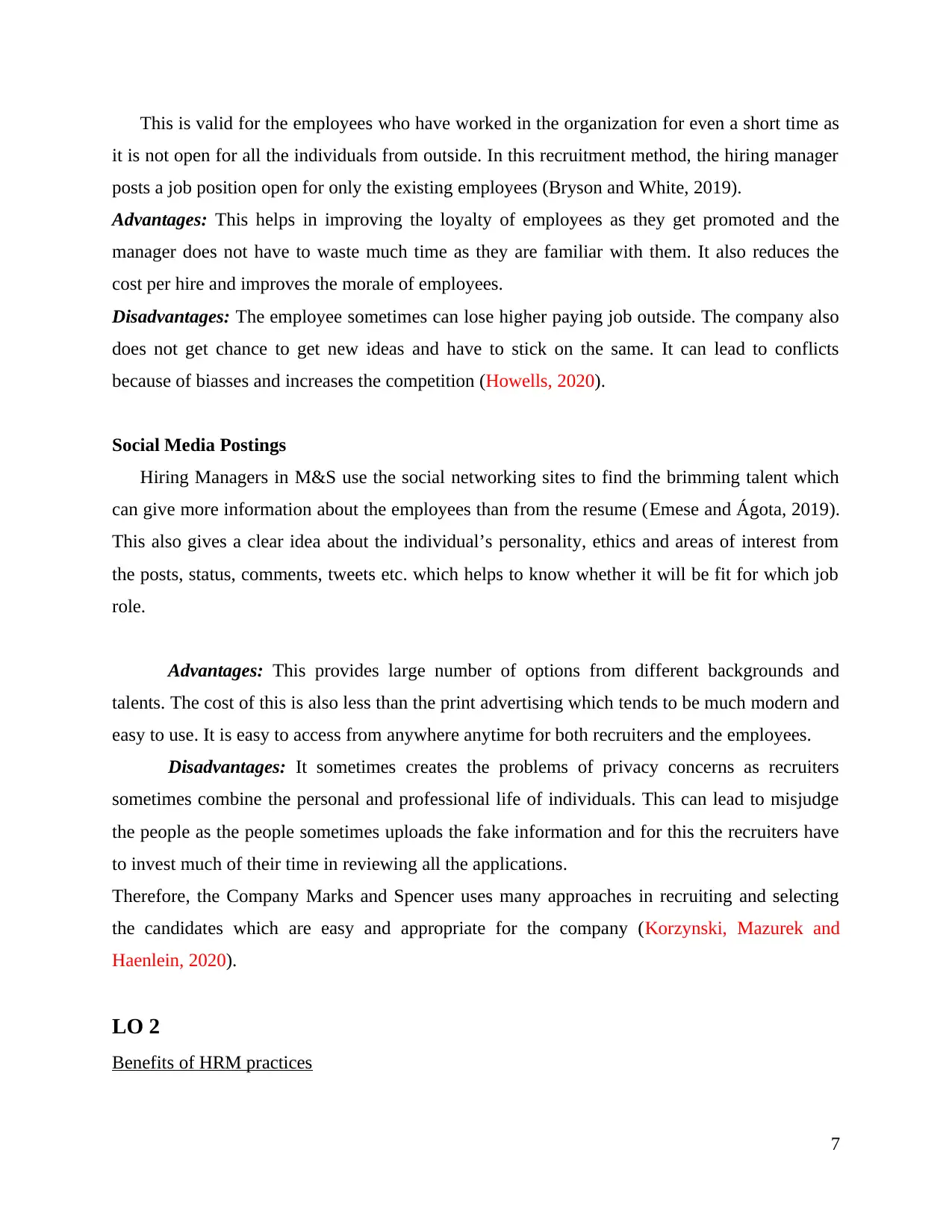
This is valid for the employees who have worked in the organization for even a short time as
it is not open for all the individuals from outside. In this recruitment method, the hiring manager
posts a job position open for only the existing employees (Bryson and White, 2019).
Advantages: This helps in improving the loyalty of employees as they get promoted and the
manager does not have to waste much time as they are familiar with them. It also reduces the
cost per hire and improves the morale of employees.
Disadvantages: The employee sometimes can lose higher paying job outside. The company also
does not get chance to get new ideas and have to stick on the same. It can lead to conflicts
because of biasses and increases the competition (Howells, 2020).
Social Media Postings
Hiring Managers in M&S use the social networking sites to find the brimming talent which
can give more information about the employees than from the resume (Emese and Ágota, 2019).
This also gives a clear idea about the individual’s personality, ethics and areas of interest from
the posts, status, comments, tweets etc. which helps to know whether it will be fit for which job
role.
Advantages: This provides large number of options from different backgrounds and
talents. The cost of this is also less than the print advertising which tends to be much modern and
easy to use. It is easy to access from anywhere anytime for both recruiters and the employees.
Disadvantages: It sometimes creates the problems of privacy concerns as recruiters
sometimes combine the personal and professional life of individuals. This can lead to misjudge
the people as the people sometimes uploads the fake information and for this the recruiters have
to invest much of their time in reviewing all the applications.
Therefore, the Company Marks and Spencer uses many approaches in recruiting and selecting
the candidates which are easy and appropriate for the company (Korzynski, Mazurek and
Haenlein, 2020).
LO 2
Benefits of HRM practices
7
it is not open for all the individuals from outside. In this recruitment method, the hiring manager
posts a job position open for only the existing employees (Bryson and White, 2019).
Advantages: This helps in improving the loyalty of employees as they get promoted and the
manager does not have to waste much time as they are familiar with them. It also reduces the
cost per hire and improves the morale of employees.
Disadvantages: The employee sometimes can lose higher paying job outside. The company also
does not get chance to get new ideas and have to stick on the same. It can lead to conflicts
because of biasses and increases the competition (Howells, 2020).
Social Media Postings
Hiring Managers in M&S use the social networking sites to find the brimming talent which
can give more information about the employees than from the resume (Emese and Ágota, 2019).
This also gives a clear idea about the individual’s personality, ethics and areas of interest from
the posts, status, comments, tweets etc. which helps to know whether it will be fit for which job
role.
Advantages: This provides large number of options from different backgrounds and
talents. The cost of this is also less than the print advertising which tends to be much modern and
easy to use. It is easy to access from anywhere anytime for both recruiters and the employees.
Disadvantages: It sometimes creates the problems of privacy concerns as recruiters
sometimes combine the personal and professional life of individuals. This can lead to misjudge
the people as the people sometimes uploads the fake information and for this the recruiters have
to invest much of their time in reviewing all the applications.
Therefore, the Company Marks and Spencer uses many approaches in recruiting and selecting
the candidates which are easy and appropriate for the company (Korzynski, Mazurek and
Haenlein, 2020).
LO 2
Benefits of HRM practices
7
Paraphrase This Document
Need a fresh take? Get an instant paraphrase of this document with our AI Paraphraser
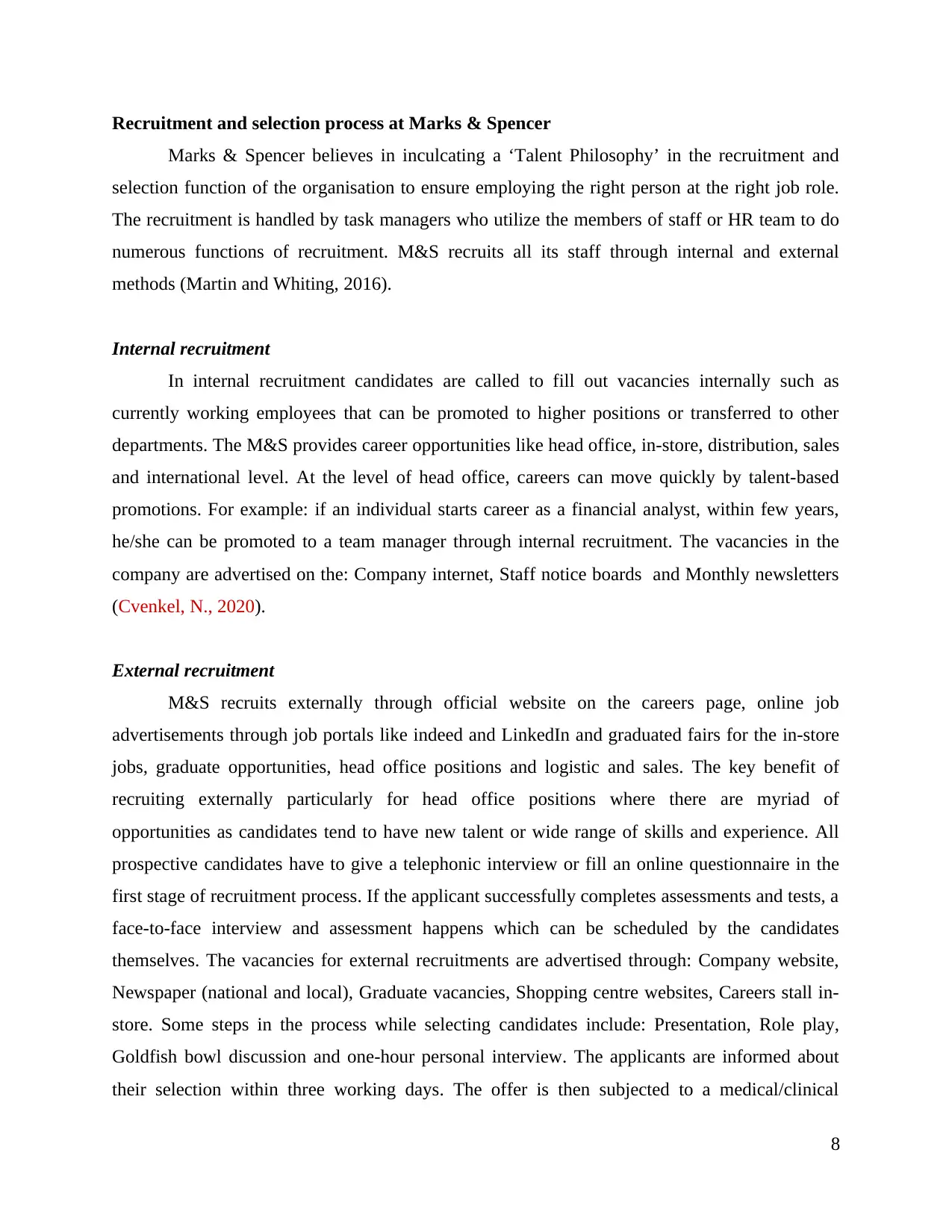
Recruitment and selection process at Marks & Spencer
Marks & Spencer believes in inculcating a ‘Talent Philosophy’ in the recruitment and
selection function of the organisation to ensure employing the right person at the right job role.
The recruitment is handled by task managers who utilize the members of staff or HR team to do
numerous functions of recruitment. M&S recruits all its staff through internal and external
methods (Martin and Whiting, 2016).
Internal recruitment
In internal recruitment candidates are called to fill out vacancies internally such as
currently working employees that can be promoted to higher positions or transferred to other
departments. The M&S provides career opportunities like head office, in-store, distribution, sales
and international level. At the level of head office, careers can move quickly by talent-based
promotions. For example: if an individual starts career as a financial analyst, within few years,
he/she can be promoted to a team manager through internal recruitment. The vacancies in the
company are advertised on the: Company internet, Staff notice boards and Monthly newsletters
(Cvenkel, N., 2020).
External recruitment
M&S recruits externally through official website on the careers page, online job
advertisements through job portals like indeed and LinkedIn and graduated fairs for the in-store
jobs, graduate opportunities, head office positions and logistic and sales. The key benefit of
recruiting externally particularly for head office positions where there are myriad of
opportunities as candidates tend to have new talent or wide range of skills and experience. All
prospective candidates have to give a telephonic interview or fill an online questionnaire in the
first stage of recruitment process. If the applicant successfully completes assessments and tests, a
face-to-face interview and assessment happens which can be scheduled by the candidates
themselves. The vacancies for external recruitments are advertised through: Company website,
Newspaper (national and local), Graduate vacancies, Shopping centre websites, Careers stall in-
store. Some steps in the process while selecting candidates include: Presentation, Role play,
Goldfish bowl discussion and one-hour personal interview. The applicants are informed about
their selection within three working days. The offer is then subjected to a medical/clinical
8
Marks & Spencer believes in inculcating a ‘Talent Philosophy’ in the recruitment and
selection function of the organisation to ensure employing the right person at the right job role.
The recruitment is handled by task managers who utilize the members of staff or HR team to do
numerous functions of recruitment. M&S recruits all its staff through internal and external
methods (Martin and Whiting, 2016).
Internal recruitment
In internal recruitment candidates are called to fill out vacancies internally such as
currently working employees that can be promoted to higher positions or transferred to other
departments. The M&S provides career opportunities like head office, in-store, distribution, sales
and international level. At the level of head office, careers can move quickly by talent-based
promotions. For example: if an individual starts career as a financial analyst, within few years,
he/she can be promoted to a team manager through internal recruitment. The vacancies in the
company are advertised on the: Company internet, Staff notice boards and Monthly newsletters
(Cvenkel, N., 2020).
External recruitment
M&S recruits externally through official website on the careers page, online job
advertisements through job portals like indeed and LinkedIn and graduated fairs for the in-store
jobs, graduate opportunities, head office positions and logistic and sales. The key benefit of
recruiting externally particularly for head office positions where there are myriad of
opportunities as candidates tend to have new talent or wide range of skills and experience. All
prospective candidates have to give a telephonic interview or fill an online questionnaire in the
first stage of recruitment process. If the applicant successfully completes assessments and tests, a
face-to-face interview and assessment happens which can be scheduled by the candidates
themselves. The vacancies for external recruitments are advertised through: Company website,
Newspaper (national and local), Graduate vacancies, Shopping centre websites, Careers stall in-
store. Some steps in the process while selecting candidates include: Presentation, Role play,
Goldfish bowl discussion and one-hour personal interview. The applicants are informed about
their selection within three working days. The offer is then subjected to a medical/clinical
8
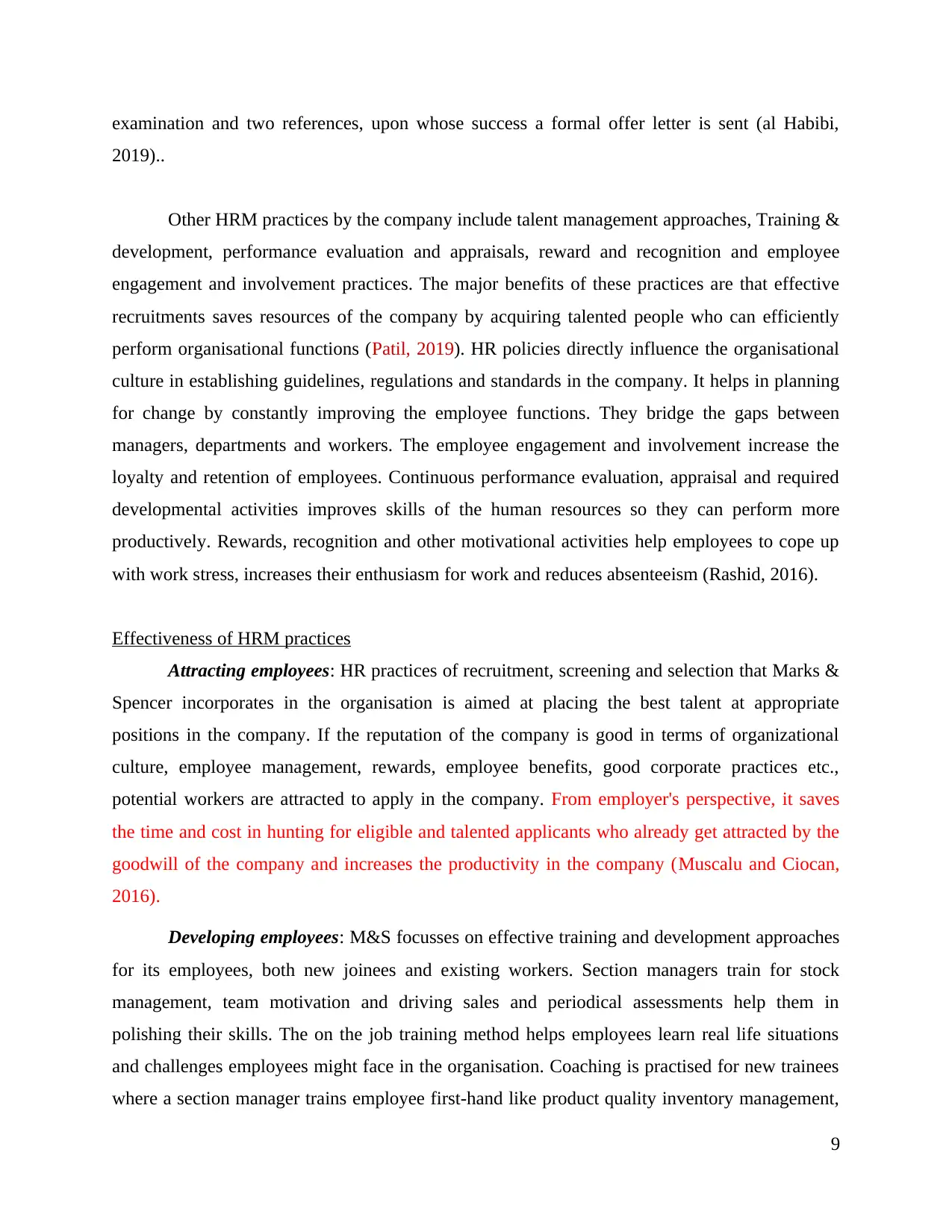
examination and two references, upon whose success a formal offer letter is sent (al Habibi,
2019)..
Other HRM practices by the company include talent management approaches, Training &
development, performance evaluation and appraisals, reward and recognition and employee
engagement and involvement practices. The major benefits of these practices are that effective
recruitments saves resources of the company by acquiring talented people who can efficiently
perform organisational functions (Patil, 2019). HR policies directly influence the organisational
culture in establishing guidelines, regulations and standards in the company. It helps in planning
for change by constantly improving the employee functions. They bridge the gaps between
managers, departments and workers. The employee engagement and involvement increase the
loyalty and retention of employees. Continuous performance evaluation, appraisal and required
developmental activities improves skills of the human resources so they can perform more
productively. Rewards, recognition and other motivational activities help employees to cope up
with work stress, increases their enthusiasm for work and reduces absenteeism (Rashid, 2016).
Effectiveness of HRM practices
Attracting employees: HR practices of recruitment, screening and selection that Marks &
Spencer incorporates in the organisation is aimed at placing the best talent at appropriate
positions in the company. If the reputation of the company is good in terms of organizational
culture, employee management, rewards, employee benefits, good corporate practices etc.,
potential workers are attracted to apply in the company. From employer's perspective, it saves
the time and cost in hunting for eligible and talented applicants who already get attracted by the
goodwill of the company and increases the productivity in the company (Muscalu and Ciocan,
2016).
Developing employees: M&S focusses on effective training and development approaches
for its employees, both new joinees and existing workers. Section managers train for stock
management, team motivation and driving sales and periodical assessments help them in
polishing their skills. The on the job training method helps employees learn real life situations
and challenges employees might face in the organisation. Coaching is practised for new trainees
where a section manager trains employee first-hand like product quality inventory management,
9
2019)..
Other HRM practices by the company include talent management approaches, Training &
development, performance evaluation and appraisals, reward and recognition and employee
engagement and involvement practices. The major benefits of these practices are that effective
recruitments saves resources of the company by acquiring talented people who can efficiently
perform organisational functions (Patil, 2019). HR policies directly influence the organisational
culture in establishing guidelines, regulations and standards in the company. It helps in planning
for change by constantly improving the employee functions. They bridge the gaps between
managers, departments and workers. The employee engagement and involvement increase the
loyalty and retention of employees. Continuous performance evaluation, appraisal and required
developmental activities improves skills of the human resources so they can perform more
productively. Rewards, recognition and other motivational activities help employees to cope up
with work stress, increases their enthusiasm for work and reduces absenteeism (Rashid, 2016).
Effectiveness of HRM practices
Attracting employees: HR practices of recruitment, screening and selection that Marks &
Spencer incorporates in the organisation is aimed at placing the best talent at appropriate
positions in the company. If the reputation of the company is good in terms of organizational
culture, employee management, rewards, employee benefits, good corporate practices etc.,
potential workers are attracted to apply in the company. From employer's perspective, it saves
the time and cost in hunting for eligible and talented applicants who already get attracted by the
goodwill of the company and increases the productivity in the company (Muscalu and Ciocan,
2016).
Developing employees: M&S focusses on effective training and development approaches
for its employees, both new joinees and existing workers. Section managers train for stock
management, team motivation and driving sales and periodical assessments help them in
polishing their skills. The on the job training method helps employees learn real life situations
and challenges employees might face in the organisation. Coaching is practised for new trainees
where a section manager trains employee first-hand like product quality inventory management,
9
⊘ This is a preview!⊘
Do you want full access?
Subscribe today to unlock all pages.

Trusted by 1+ million students worldwide
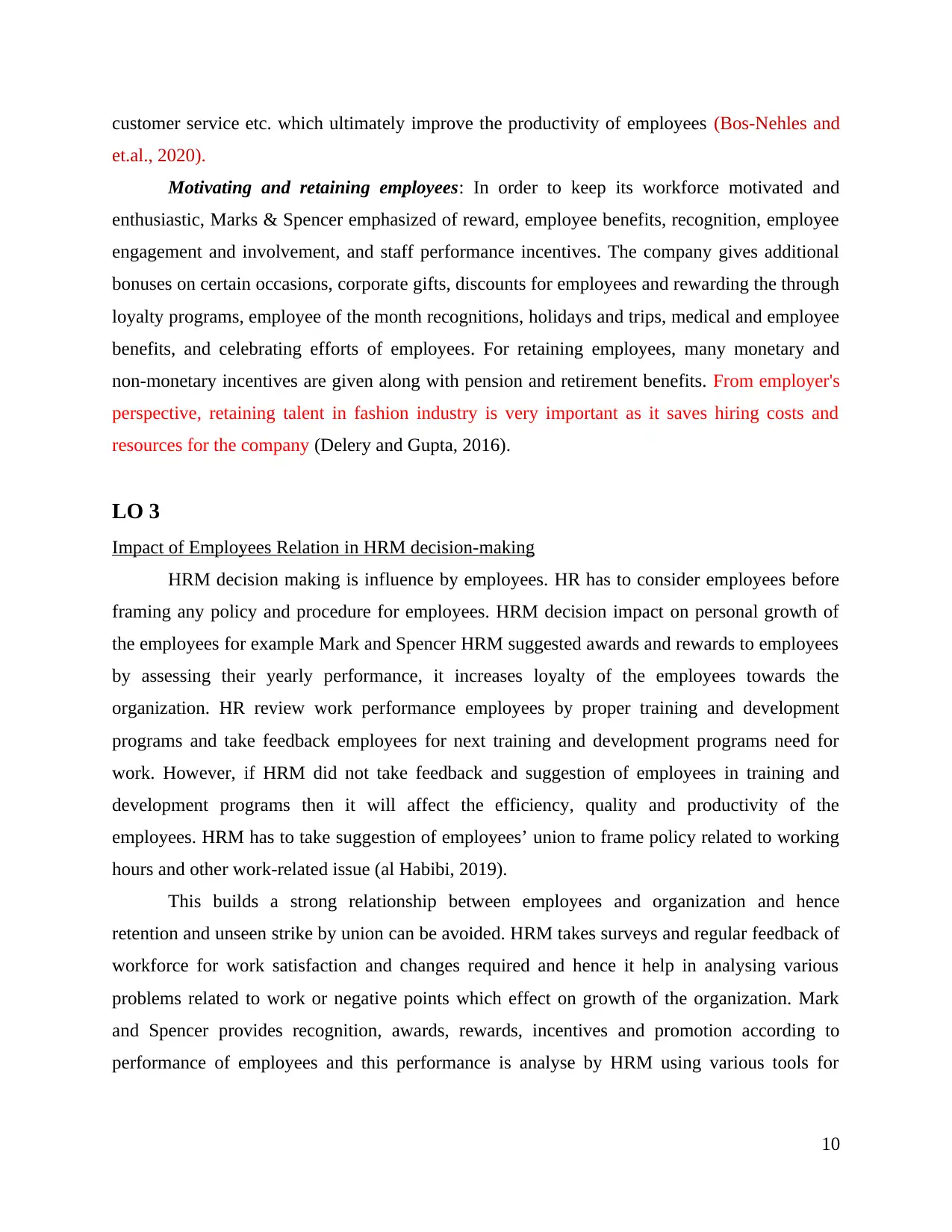
customer service etc. which ultimately improve the productivity of employees (Bos-Nehles and
et.al., 2020).
Motivating and retaining employees: In order to keep its workforce motivated and
enthusiastic, Marks & Spencer emphasized of reward, employee benefits, recognition, employee
engagement and involvement, and staff performance incentives. The company gives additional
bonuses on certain occasions, corporate gifts, discounts for employees and rewarding the through
loyalty programs, employee of the month recognitions, holidays and trips, medical and employee
benefits, and celebrating efforts of employees. For retaining employees, many monetary and
non-monetary incentives are given along with pension and retirement benefits. From employer's
perspective, retaining talent in fashion industry is very important as it saves hiring costs and
resources for the company (Delery and Gupta, 2016).
LO 3
Impact of Employees Relation in HRM decision-making
HRM decision making is influence by employees. HR has to consider employees before
framing any policy and procedure for employees. HRM decision impact on personal growth of
the employees for example Mark and Spencer HRM suggested awards and rewards to employees
by assessing their yearly performance, it increases loyalty of the employees towards the
organization. HR review work performance employees by proper training and development
programs and take feedback employees for next training and development programs need for
work. However, if HRM did not take feedback and suggestion of employees in training and
development programs then it will affect the efficiency, quality and productivity of the
employees. HRM has to take suggestion of employees’ union to frame policy related to working
hours and other work-related issue (al Habibi, 2019).
This builds a strong relationship between employees and organization and hence
retention and unseen strike by union can be avoided. HRM takes surveys and regular feedback of
workforce for work satisfaction and changes required and hence it help in analysing various
problems related to work or negative points which effect on growth of the organization. Mark
and Spencer provides recognition, awards, rewards, incentives and promotion according to
performance of employees and this performance is analyse by HRM using various tools for
10
et.al., 2020).
Motivating and retaining employees: In order to keep its workforce motivated and
enthusiastic, Marks & Spencer emphasized of reward, employee benefits, recognition, employee
engagement and involvement, and staff performance incentives. The company gives additional
bonuses on certain occasions, corporate gifts, discounts for employees and rewarding the through
loyalty programs, employee of the month recognitions, holidays and trips, medical and employee
benefits, and celebrating efforts of employees. For retaining employees, many monetary and
non-monetary incentives are given along with pension and retirement benefits. From employer's
perspective, retaining talent in fashion industry is very important as it saves hiring costs and
resources for the company (Delery and Gupta, 2016).
LO 3
Impact of Employees Relation in HRM decision-making
HRM decision making is influence by employees. HR has to consider employees before
framing any policy and procedure for employees. HRM decision impact on personal growth of
the employees for example Mark and Spencer HRM suggested awards and rewards to employees
by assessing their yearly performance, it increases loyalty of the employees towards the
organization. HR review work performance employees by proper training and development
programs and take feedback employees for next training and development programs need for
work. However, if HRM did not take feedback and suggestion of employees in training and
development programs then it will affect the efficiency, quality and productivity of the
employees. HRM has to take suggestion of employees’ union to frame policy related to working
hours and other work-related issue (al Habibi, 2019).
This builds a strong relationship between employees and organization and hence
retention and unseen strike by union can be avoided. HRM takes surveys and regular feedback of
workforce for work satisfaction and changes required and hence it help in analysing various
problems related to work or negative points which effect on growth of the organization. Mark
and Spencer provides recognition, awards, rewards, incentives and promotion according to
performance of employees and this performance is analyse by HRM using various tools for
10
Paraphrase This Document
Need a fresh take? Get an instant paraphrase of this document with our AI Paraphraser
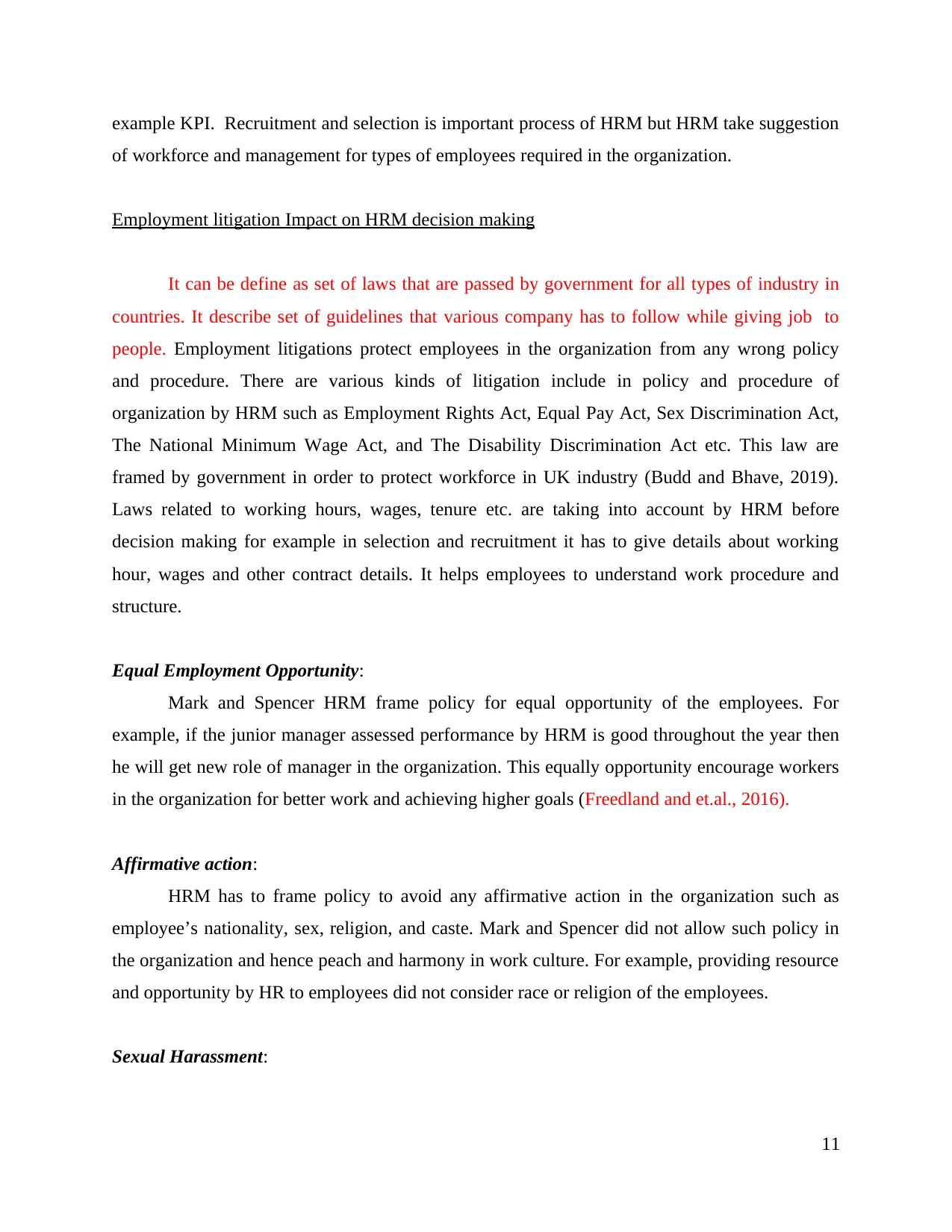
example KPI. Recruitment and selection is important process of HRM but HRM take suggestion
of workforce and management for types of employees required in the organization.
Employment litigation Impact on HRM decision making
It can be define as set of laws that are passed by government for all types of industry in
countries. It describe set of guidelines that various company has to follow while giving job to
people. Employment litigations protect employees in the organization from any wrong policy
and procedure. There are various kinds of litigation include in policy and procedure of
organization by HRM such as Employment Rights Act, Equal Pay Act, Sex Discrimination Act,
The National Minimum Wage Act, and The Disability Discrimination Act etc. This law are
framed by government in order to protect workforce in UK industry (Budd and Bhave, 2019).
Laws related to working hours, wages, tenure etc. are taking into account by HRM before
decision making for example in selection and recruitment it has to give details about working
hour, wages and other contract details. It helps employees to understand work procedure and
structure.
Equal Employment Opportunity:
Mark and Spencer HRM frame policy for equal opportunity of the employees. For
example, if the junior manager assessed performance by HRM is good throughout the year then
he will get new role of manager in the organization. This equally opportunity encourage workers
in the organization for better work and achieving higher goals (Freedland and et.al., 2016).
Affirmative action:
HRM has to frame policy to avoid any affirmative action in the organization such as
employee’s nationality, sex, religion, and caste. Mark and Spencer did not allow such policy in
the organization and hence peach and harmony in work culture. For example, providing resource
and opportunity by HR to employees did not consider race or religion of the employees.
Sexual Harassment:
11
of workforce and management for types of employees required in the organization.
Employment litigation Impact on HRM decision making
It can be define as set of laws that are passed by government for all types of industry in
countries. It describe set of guidelines that various company has to follow while giving job to
people. Employment litigations protect employees in the organization from any wrong policy
and procedure. There are various kinds of litigation include in policy and procedure of
organization by HRM such as Employment Rights Act, Equal Pay Act, Sex Discrimination Act,
The National Minimum Wage Act, and The Disability Discrimination Act etc. This law are
framed by government in order to protect workforce in UK industry (Budd and Bhave, 2019).
Laws related to working hours, wages, tenure etc. are taking into account by HRM before
decision making for example in selection and recruitment it has to give details about working
hour, wages and other contract details. It helps employees to understand work procedure and
structure.
Equal Employment Opportunity:
Mark and Spencer HRM frame policy for equal opportunity of the employees. For
example, if the junior manager assessed performance by HRM is good throughout the year then
he will get new role of manager in the organization. This equally opportunity encourage workers
in the organization for better work and achieving higher goals (Freedland and et.al., 2016).
Affirmative action:
HRM has to frame policy to avoid any affirmative action in the organization such as
employee’s nationality, sex, religion, and caste. Mark and Spencer did not allow such policy in
the organization and hence peach and harmony in work culture. For example, providing resource
and opportunity by HR to employees did not consider race or religion of the employees.
Sexual Harassment:
11
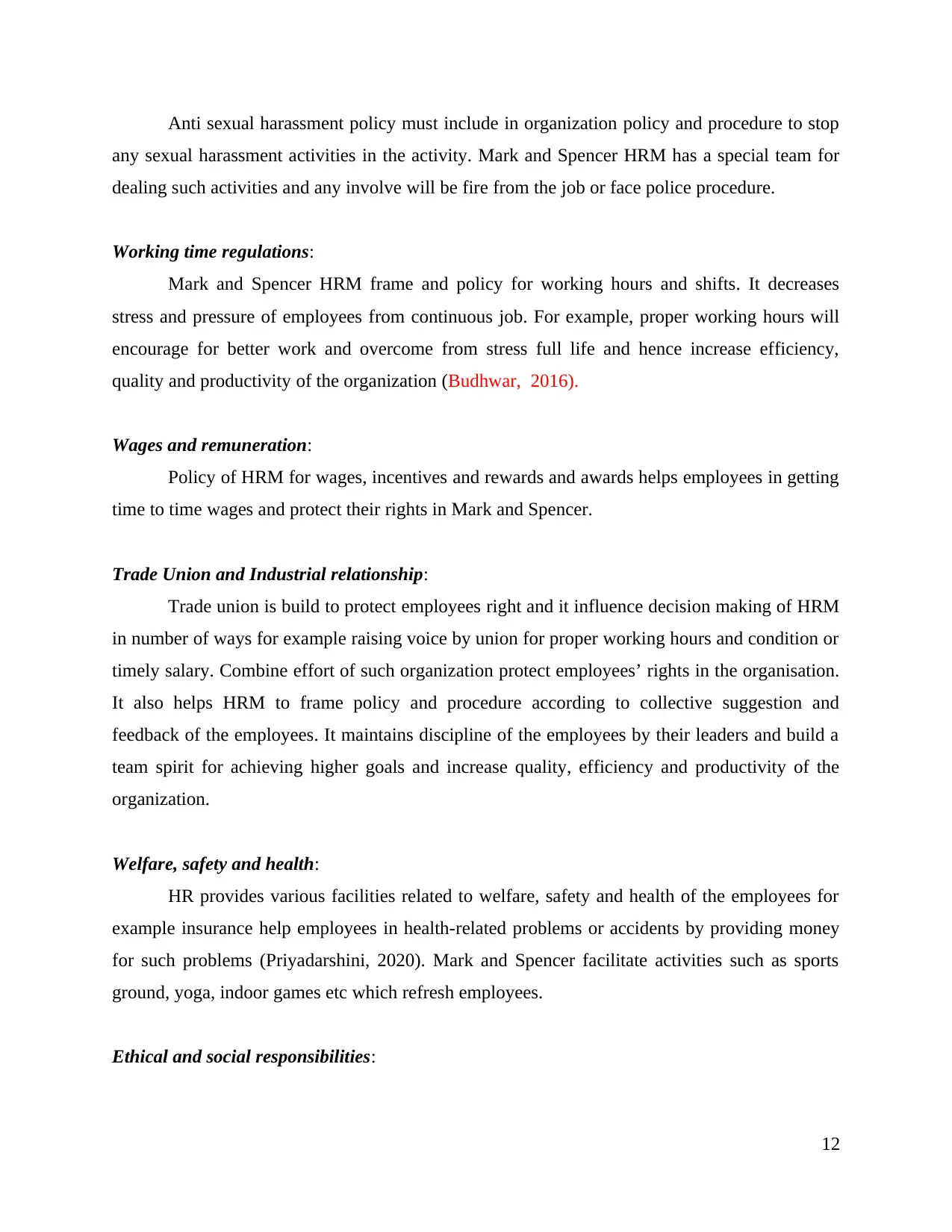
Anti sexual harassment policy must include in organization policy and procedure to stop
any sexual harassment activities in the activity. Mark and Spencer HRM has a special team for
dealing such activities and any involve will be fire from the job or face police procedure.
Working time regulations:
Mark and Spencer HRM frame and policy for working hours and shifts. It decreases
stress and pressure of employees from continuous job. For example, proper working hours will
encourage for better work and overcome from stress full life and hence increase efficiency,
quality and productivity of the organization (Budhwar, 2016).
Wages and remuneration:
Policy of HRM for wages, incentives and rewards and awards helps employees in getting
time to time wages and protect their rights in Mark and Spencer.
Trade Union and Industrial relationship:
Trade union is build to protect employees right and it influence decision making of HRM
in number of ways for example raising voice by union for proper working hours and condition or
timely salary. Combine effort of such organization protect employees’ rights in the organisation.
It also helps HRM to frame policy and procedure according to collective suggestion and
feedback of the employees. It maintains discipline of the employees by their leaders and build a
team spirit for achieving higher goals and increase quality, efficiency and productivity of the
organization.
Welfare, safety and health:
HR provides various facilities related to welfare, safety and health of the employees for
example insurance help employees in health-related problems or accidents by providing money
for such problems (Priyadarshini, 2020). Mark and Spencer facilitate activities such as sports
ground, yoga, indoor games etc which refresh employees.
Ethical and social responsibilities:
12
any sexual harassment activities in the activity. Mark and Spencer HRM has a special team for
dealing such activities and any involve will be fire from the job or face police procedure.
Working time regulations:
Mark and Spencer HRM frame and policy for working hours and shifts. It decreases
stress and pressure of employees from continuous job. For example, proper working hours will
encourage for better work and overcome from stress full life and hence increase efficiency,
quality and productivity of the organization (Budhwar, 2016).
Wages and remuneration:
Policy of HRM for wages, incentives and rewards and awards helps employees in getting
time to time wages and protect their rights in Mark and Spencer.
Trade Union and Industrial relationship:
Trade union is build to protect employees right and it influence decision making of HRM
in number of ways for example raising voice by union for proper working hours and condition or
timely salary. Combine effort of such organization protect employees’ rights in the organisation.
It also helps HRM to frame policy and procedure according to collective suggestion and
feedback of the employees. It maintains discipline of the employees by their leaders and build a
team spirit for achieving higher goals and increase quality, efficiency and productivity of the
organization.
Welfare, safety and health:
HR provides various facilities related to welfare, safety and health of the employees for
example insurance help employees in health-related problems or accidents by providing money
for such problems (Priyadarshini, 2020). Mark and Spencer facilitate activities such as sports
ground, yoga, indoor games etc which refresh employees.
Ethical and social responsibilities:
12
⊘ This is a preview!⊘
Do you want full access?
Subscribe today to unlock all pages.

Trusted by 1+ million students worldwide
1 out of 18
Related Documents
Your All-in-One AI-Powered Toolkit for Academic Success.
+13062052269
info@desklib.com
Available 24*7 on WhatsApp / Email
![[object Object]](/_next/static/media/star-bottom.7253800d.svg)
Unlock your academic potential
Copyright © 2020–2025 A2Z Services. All Rights Reserved. Developed and managed by ZUCOL.





